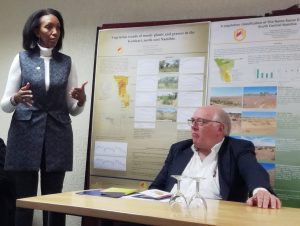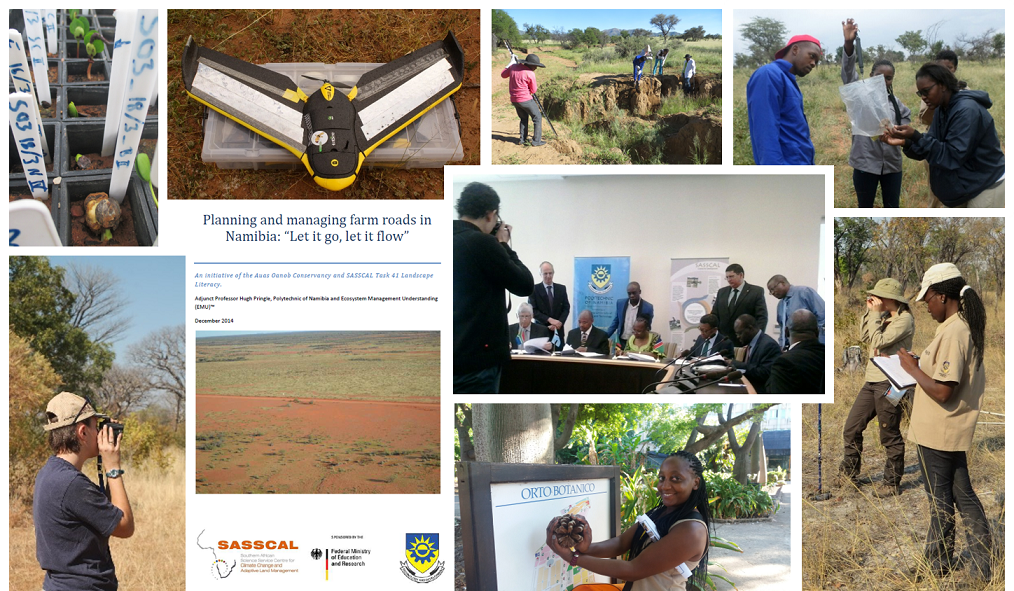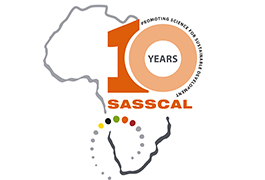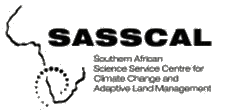The Namibian University of Science and Technology (NUST, formerly Polytechnic of Namibia) hosted a SASSCAL Projects Information Sharing Session on 04 July 2017. SASSCAL and the Namibian Stakeholder Ministries were invited at the event.
Dr Rolf Becker, the Dean of Natural Resources and Spatial Sciences, opened the event, by outlining the value of SASSCAL’s Research Portfolio to the development, capacity building and research goals of NUST, in order to contribute with applied research to the sustainable development of Namibia and the region.
Dr Jane Olwoch, the Executive Director of SASSCAL, put the value of SASSCAL into context, by outlining a changing and uncertain future for the sub-Saharan region. Ecosystem services cannot afford to have a national focus, if climatic effects are felt across the region and are not constrained by international borders. Dr Olwoch presented some of the work that SASSCAL has been engaged with, to contribute to challenges provided by growing populations, limited natural resources and predictions of a drier and hotter sub-Saharan Africa. Dr. Olwoch also stressed the focus of SASSCAL II, that is, service provision and a broader focus on regionality perspective.

Dr Rolf Becker, the Dean of Natural Resources and Spatial Sciences, listening to the presentation of Dr Jane Olwoch, the SASSCAL Executive Director
The Namibian University of Science and Technology has nine SASSCAL tasks. The PI of every task presented the objectives, methodology, results and challenges of their task(s):
- Dr Ibo Zimmermann presented Task 041, Landscape Literacy, that applied landscape restoration techniques at test sites in Namibia, using available local resources to address landscape degradation issues. Dr Zimmermann demonstrated promising and convincing effects to the available grazing land.
- Dr Vera de Cauwer presented Task 038, Forest Regeneration, Growth Rates, Threads and Trends in different Forest Types, that addressed regeneration challenges of certain forest species. Amongst others, she demonstrated the detrimental effect induced by regular forest fires, that don’t allow young tree saplings to survive. In particular, some forest species are more sensitive to regular burning and according, regular burns alter the forest species composition.
- Dr Ben Strohbach presented Tasks 062, Strengthening a Regional Biodiversity Observation Network in the Region, and Task 159, Vegetation Survey of Namibia. Dr Stohbach provided background on the biodiversity observatories in Namibia, whose distribution aims at presenting land use contrasts, in particular for protected areas compared to communal areas. In order to support the monitoring activities of the observatories, the eBee UAV had been bought, that allows, amongst many others, for the regular monitoring of observatories and the identification of different tree species from the imagery. Dr Stohbach also gave insight into progress made with creating an updated and refined vegetation map for Namibia. In this context, he stressed the thread posed by aggressive alien species such as the prosopis tree. Another product in development through his task is a suitability index for livestock farming.

Impressions from the SASSCAL Research Portfolio at NUST
- Mr Lameck Mwewa presented Task 303, Postgraduate Programme in Applied Science in Earth Observation, GIS and Remote Sensing. The programme was created in a collaboration between NUST, UNZA (University of Zambia), UB (University of Botswana) and CPUT (Cape Peninsula University of Technology). The Master programme was first launched in November 2016 in Namibia. 14 Students from NUST started the programme in July 2016 and are fully funded by SASSCAL. In the meantime, 22 students started in May 2017 at UNZA on which the programme was officially launched on the 6th June, 2017. The programme is yet to be launched in Botswana this September.
- Dr Nicky Knox presented Task 033, Development of a National Forest Monitoring Programme. One component of the task analysed the land cover change in the Zambezi and northern Kavango regions for 1984, 1991, 2000 and 2010, from Landsat imagery, determining the changes to the woodlands in the protected areas versus those of the communal areas. Dr Knox also described analyses conducted on socio-economic drivers impacting forests, such as irregular rainfall, the use of woodland materials in bad years, research conducted on the impact of the rainfall gradient on carbon storage in woodland ecosystems and ongoing work conducted by students in determining soil respiration in forest areas.
- Dr Dave Joubert presented Task(s) 072, Impact of Bush Encroachment on Water, and 148, The impacts of Fire on Biodiversity and Ecosystem Processes in Woodland Savanna Resources. The extent of bush encroachment is well-known and documented, but poorly understood. Dr Joubert announced that a workshop will be held at Waterberg Park in August 2017, to present the results from his research. Dr Joubert further reported that in regard to the impact of fires, it was surprising to find that fires do not appear to have a detrimental effect on soils on the Waterberg plateau (except on the sodium content). Furthermore, no effect was found on the species composition of woody species, contrary to the effects of frost. The movements of collared buffalo on the plateau demonstrated a magnetic effect towards previously burned areas, even after a period of over a year after the burn. Accordingly, controlled fires appear to improve the usage of nutrition and habitat.
- Prof Percy Chimwamurombe presented Task 051, Improved Soil Fertility Management, which aimed at identifying drought resistant indigenous legumes that can also thrive in poor soils. Prof Chimwamurombe explained that so far, all work had been conducted in growth houses and still should be tested in the field. One aspect of his work had been the identification of nitrogen fixing symbionts, that increase crop production and which will likely be made available for sale to farmers.




